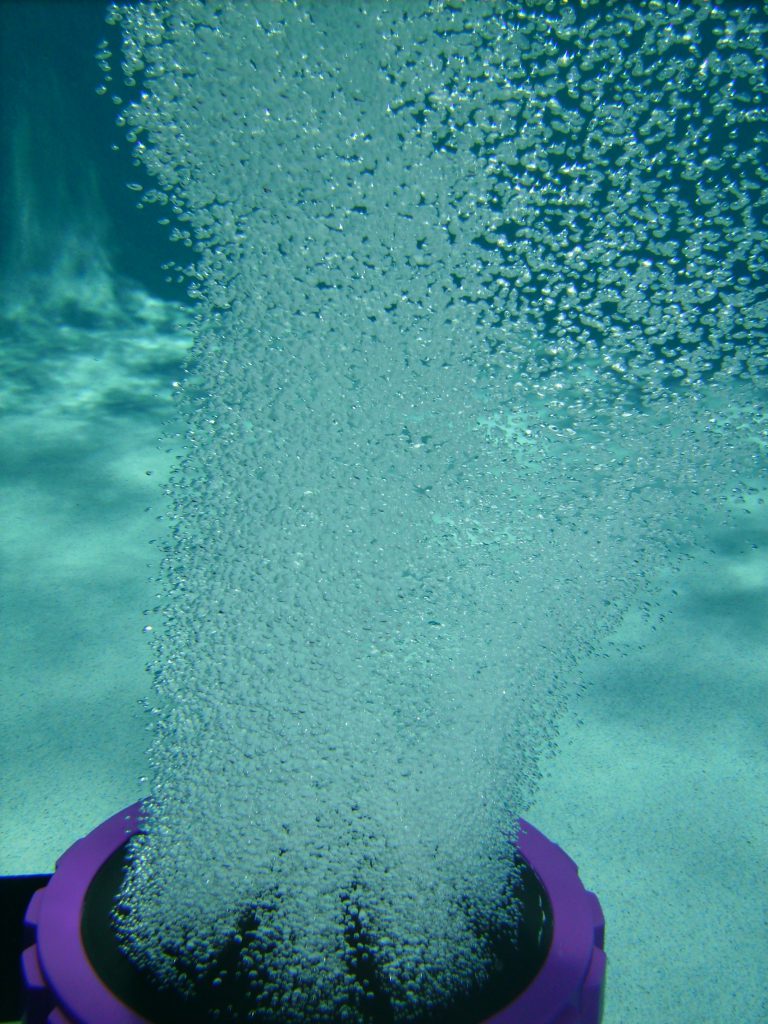
Support Your Waterbody with Dissolved Oxygen
Air is all around us, but did you know that it’s also found in our lakes and ponds? A healthy aquatic ecosystem contains dissolved oxygen that circulates freely throughout the water column. The oxygen is absorbed by plants and fish – among other lifeforms – to sustain the entire food chain. Dissolved oxygen also balances pH and supports water quality conditions to prevent algae, weeds, bottom muck, and toxic cyanobacteria. Unfortunately, many factors can reduce sufficient levels of dissolved oxygen and impede these important processes. That’s where supplemental solutions come in.
Dissolved oxygen can be supplementally introduced to the water column in a number of ways: Floating fountains aerate and circulate water near the surface, whereas submersed aeration systems release dissolved oxygen from the depths of the waterbody. Likewise, new industry technologies can be used to directly saturate the entire water column with abundant levels of oxygen. Aeration can be beneficial for nearly any lake or pond, but it’s important to understand their key differences so they can be implemented strategically in your waterbody.
Join us for our upcoming free webinar to learn more about your aeration options! Click the link below.

Floating Fountains
Floating fountains are often used to create dynamic, eye-catching movement (and even beautiful lighting) in a lake or pond, but that’s not all they do. Fountains are capable of mixing high volumes of water near the surface by sucking water through a pump and propelling it into the air. As water splashes back down, it creates turbulence that allows the transfer of oxygen and vents undesirable gases. This turbulence also helps keep the water’s surface clear of biofilm and thwarts mosquito reproduction.

Submersed Aeration Systems
Like fountains, submersed aerators utilize water movement to increase oxygen levels and circulate the water column, but these devices work from the bottom. On-shore compressors pump air through subsurface tubes into the depths of the waterbody. As the air rises from the sediment, it carries the low-oxygen water upwards and mixes it with the oxygen-rich water near the surface. This continuous vertical circulation helps eliminate bad odors that build up when organic matter decomposes. It also prevents the formation of distinct “layers” characterized by varying degrees of oxygen and temperature. This is a huge factor in preventing fish kills during seasonal and weather changes.

Which Solution Is the Best Fit for Your Waterbody?
Nearly every waterbody can benefit from aeration, but choosing the right configuration is just as important. Though multipurpose, fountains have their limitations. Because they float, they can only impact the surface of the water. If aeration is a primary goal, professional lake managers do not typically recommend fountains alone for deeper lakes and ponds. Conversely, submersed aeration is an effective solution for deeper waterbodies. It is also a more affordable and energy-efficient alternative to fountains, though it does not provide the aesthetically pleasing visuals some stakeholders may desire. Lake management professionals can use GPS technology to identify the unique depths and contours of a waterbody and ensure the equipment is placed in the appropriate location for maximum benefits.
A Toolbox of Proactive Solutions
How are these many aeration solutions utilized in a typical lake management program? Well, there is no such thing as a “typical” program. All waterbodies come with their own unique characteristics, challenges, budget, and stakeholder goals, which is why it’s common to see these and other management tools used in a variety of combinations. For instance, your lake manager may recommend introducing a floating fountain for surface circulation and placing a submersed aerator underneath for added oxygenation. Or, depending on the needs of your waterbody, they might recommend Nanobubbles or a brand new industry innovation called Direct Oxygen Saturation. Direct Oxygen Saturation technology has just entered the industry so be sure to keep an eye out for more information soon!
Aeration is an amazing tool, but it cannot solve lake management problems alone. A layered approach combines a toolbox of proactive solutions like water quality testing and nutrient remediation with advanced strategies like highly-targeted herbicides and mechanical sediment removal to responsibly address concerns when they do arise. Consider our SOL PRO Annual Management Programs for ongoing aquatic support.









